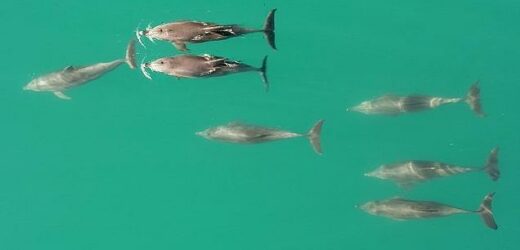Dolphins have ‘wingmen’ just like humans! Study shows males work together to court females and boost their chances of reproducing
- Male bottlenose dolphins form tactical alliances to court females together
- Some alliances also cooperate as larger groups, forming a multilevel society
- It was previously thought that strategic cooperation was unique to humans
- Their bonds allow the male dolphins to have more time to woo their mate
It turns out that employing a ‘wingman’ to help you find a partner is not just reserved for Ocean nightclub – dolphins use the same technique in the deep blue itself!
Male bottlenose dolphins have been found to form tactical alliances with other males, who will then compete together against rival alliances for access to females.
A research team led by the University of Bristol studied the marine mammals and discovered that they build more alliances than any species other than humans.
They also found that different groups of allied dolphins will co-operate, allowing males to spend more time with the females they are pursuing, and resulting in the long-term benefit of reproductive success.
Co-lead author Dr Stephanie King said: ‘Our work highlights that dolphin societies, as well as those of nonhuman primates, are valuable model systems for understanding human social and cognitive evolution.’
Male bottlenose dolphins have been found to form tactical alliances with other males, who will then compete together against rival alliances for access to females. Pictured are six allied males with a female consort
The researchers from the UK, USA and Switzerland observed 121 adult male Indo-Pacific bottlenose dolphins at Shark Bay, Western Australia. Pictured are four male allies and a female
Humans make tactical partnerships within international trade, the military, the family unit and many other situations.
‘Cooperation between allies is widespread in human societies and one of the hallmarks of our success,’ said Dr King.
Our ability to do this was once thought to distinguish us from our chimpanzee ancestors, and was born from the evolution of pair bonds and men caring as parents.
However, a study, published today in The Proceedings of the National Academy of Sciences, has revealed that shared childcare is not essential for team-building in nature.
Study co-lead author Professor Richard Connor, of the University of Massachusetts, said: ‘Our results show that intergroup alliances can emerge without these features, from a social and mating system that is more chimpanzee like.’
Experts at the University of Bristol found that dolphins whistle to each other as part of a male bonding ritual.
It is a less time-demanding way to maintain weaker alliances than other physical bonding activities like petting and rubbing.
This is an important interaction to maintain when groups become larger and competition over resources increases.
The researchers from the UK, USA and Switzerland observed 121 adult male Indo-Pacific bottlenose dolphins at Shark Bay, Western Australia.
First-order alliances form between a male dolphin and two or three other individuals who court females together, steal them from other alliances or defend against attacks.
Some first-order alliances then team up together to form second-order alliances, making groups of four to 14 co-operating dolphins.
These then compete with other second-order alliances over access to female dolphins, or join forces again to make third-order alliances.
The strategic groups allow for individuals to spend a longer time bonding with potential mates, as opposed to in competition.
Dr King added: ‘Not only have we shown that male bottlenose dolphins form the largest known multilevel alliance network outside humans, but that cooperative relationships between groups, rather than simply alliance size, allows males to spend more time with females, thereby increasing their reproductive success.’
Dr Simon Allen, Senior Lecturer at Bristol’s School of Biological Sciences, added: ‘We show that the duration over which these teams of male dolphins consort females is dependent upon being well-connected with third-order allies, that is, social ties between alliances leads to long-term benefits for these males.
The investigation has shed light on how character traits previously thought to be uniquely human can be gained.
Dolphins have regional accents that are influenced by where they live, study finds
Dolphins’ signature whistles are influenced by where they live – just like regional accents in humans, a new study has found.
Bottlenose dolphins have signature whistles that they use to identify each other. These noises are unique to each animal.
However, the new study found that the acoustic features of each dolphin’s whistles are influenced by its local habitat and community.
The team say the local ocean environment – such as areas with seagrass or muddy sea bottoms – had a much bigger part to play on these whistles than genetics.
Read more here
Source: Read Full Article




